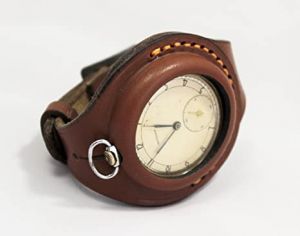Watch Straps

Watch Straps
There as many types of straps as there are watches...and that is a lot! It is proposed here to outline the types of straps and materials used, as well as pointing collectors in the direction for the correct one for their prized possession.
Watch Strap Terminology
Straps
- Width - how wide the strap is, in order for it to fit between the case lugs. Normally in millimeters now, but up to the 1980s it is also seen in imperial inches. Common sizes are 16mm. 18mm. 20mm and 22mm.
- Length - how long both parts of the strap are, normally measured in millimeters, eg 115/75. The can be found is short, medium and long which normally accomodates a 6.5 to 8 inch wrist (
- Taper - how narrow the end of the strap is at the buckle compared to the lug width eg 18/14, 20/16 or in modern cases no taper eg 20/20. Older straps had much more pronounced tapers with smaller buckles
- Keeper/Loop - the small retaining loop in which the end of the strap can be tucked to stop it flapping loose. Can be fixed, eg attached to the strap, or floating eg free to move.
- Contour - Contour fit end straps offer greater elegance. Their contoured ends that fit flush against the contours of the watch case. Because the exact distance from the spring pins to the watch case and the specific curve of the case vary across watch designs, such straps are often fairly unique to a specific watch model.
- Custom - a specially designed strap that is unique to the brand or model. While these look very elegant and stylish, they have the extreme disadvantage of forcing you to buy all your replacement straps at premium prices from the watch manufacturer. Example would be the quick release straps for the Cartier Roadster.
- Quick Release - straps are detached from the watch by simply pulling the knob on their spring bar, which in turn pulls one spring end out of the hole on the watch case and they are attached by reverse action. The whole process of changing a watch strap takes seconds, instead of minutes.
- Riveted watch strap - have the visible rivets on their outer edges that hold together the folded parts, why they are also called folded link bands. This style of watch bands is popular among aviators, hence they are nicknamed pilot, aviator, or flieger watch straps.
- Bund - have the leather part covering the back of the watch case. They originate from the 1970s, when the German air force placed their pilot watches on the thick leather pads, to protect their wrists from harsh temperatures affecting the watch case. They quickly became popular among wider public.
Racing and Rally - easy on the skin in terms of ventilation and sweat, which is especially helpful in extreme situations. Therefore they are popular among racers.
Buckle
Buckles are mainly made from high quality steel, but they can be 18k gold, silver, platinum, plated, chromed and just about anything else you can imagine.
- Tang-type buckle: By far the most common. Operates just like most men's belts. 3 parts with a buckle, tang or tongue and pin. The most common leather watch buckle tongue widths are 2mm, 3mm, 4mm and 6 mm.
- Deployant clasp, inside style: On this style, the 'tail' of the watch strap goes on the inside of the clasp. While this style has a more elegant look, it does not always work with just any standard strap. Often, a custom strap is needed to prevent the tang-slot and keeper loop features of the strap from showing.
- Deployant clasp, outside style: With this second type, the tail of the strap goes on the outside--the same way it does with a standard tang-type buckle. This is the more common type and several versions are available that can fit on to most existing leather watch straps.
Strap Materials
Leather
The earliest wristwatches used leather, and it is still a favourite choice, from high end dress watches to everyday 'beaters'. Styles go in and out of fashion but there are some classics that remain constant. The straps first worn by men, during battles, were of a broad rubust nature, often extending beyond and behind the watch in order to protect it. These 'bund' style straps are still used with larger watches and ones with military association.
Nylon
Perlon
A nylon-weave single pull through Zulu-style with single floating keeper. Technically a type of nylon produced by the polymerization of caprolactam. The advantage of Perlon straps is that they have no fixed hole location. The tang of the buckle will push through at any point of the weave, thus making a perfect fit every time. They were initally used and found in military applications but are now appeal to a wider audience. Their construction makes them waterproof, fade-proof and very durable, which is an attraction to those diving. Skin diver watches look particularly good on these.
Corfam
A synthetic leather made by DuPont in the 1960s. You can read more about Corfam here.
Rubber
Vulcanized rubber was a natural choice for watch manufacturers . It has excellent strength and resilience and easily returns to its original intended shape after bending. It resists wear and tear and oxidation. It repels fats, oils and other solvents, while also limiting water absorption. It has a wide temperature range making it flexible and reliable between −80 °C to +250 °C and won’t break down until it hits temperatures above 350 °C.
The watchmaking industry first began adding rubber bands to their timepieces in the 1950’s. Rolex, Tudor, and Blancpain were some of the early timepieces found with rubber bracelets. However, it wasn’t until the 1960’s that the use of rubber bands became mainstream, largely due to its usefulness on diver and sports watches. They also found their way onto other watches with the super-compressor cases patented by Ervin Piquerez SA (EPSA) in the 1950s. The original IWC Aquatimer (1967) also came with a Tropic strap to complement a stainless steel bracelet.
Rubber straps gained popularity in the 1970s and 1980s. Watches such as the Precimax Super-Dive and Aquastar Benthos 500 appeared on rubber – usually black rather than the bright blue, orange or yellow rubber watch strap so often seen today. In the 1980s, Italian manufacturer Bonetto Cinturini came onto the watchstrap scene. Just to confuse the issue, there are many different types of rubber!
Natural rubber
Many of the early natural rubber straps didn’t perform well. The vulcanised nitrile rubber watch strap is still one of the most popular and widely used for high-performance applications. As with any rubber, its performance isn’t just determined by its type, be it Nitrile Butadiene Rubber (NBR), silicone rubber, polyurethene rubber or PVC rubber. Also important is the specific formulation.
Silicone rubber
This is a rubber-like material that seems to be less widely used for serious high-quality performance watch straps – with notable exceptions such as Sinn, who offer silicone rubber straps . While silicone can easily be shaped and coloured, it has a reputation for stickiness, a tendency to tear and propensity to attract dust and lint.
PVC rubber
Shinier than polymers like PU rubber, this is a thermoplastic vinyl polymer that’s very durable, but lacks the characteristics for high-end applications that make NBR so appealing.
PU rubber
Polyurethene rubber (‘urethene’) is another polymer with elastic properties – an elastomer – comprising a chain of organic units linked by urethene (carbamate) links. They are very durable, highly functional, but sometimes reported to be less comfortable than natural rubber.
Other rubbers
Over the years, other synthetic rubbers have been produced from petrochemical bases, including isoprene and neoprene. Both have a specialist following. In particular, isoprene straps enjoy a good reputation, but at a price that’s several times more than a top-quality vulcanised rubber watch strap.
